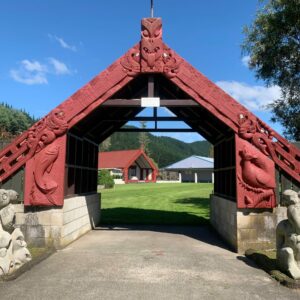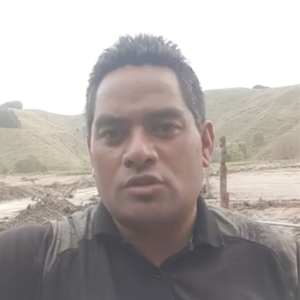On Sunday our kaumātua and whānau gathered on the road outside the Marae for a kōrero. Uncle Matiu led our karakia. Uncle stressed the importance of our whānau and hapū uniting in these difficult times – maumahara e te whānau ‘he tōtara wahi rua he kai nā te ahi’.
We also welcomed manuhiri who donated their time, at short notice, to provide informal advice on keeping our kaimahi and whānau safe at the Marae. The priority is to extract the taonga from the Marae, and we now have a plan of how to do that safely. A small team entered the Marae guided by Hōri Reti and Hoani Taurima. They examined the damage and afterwards briefed the whānau on what they saw.
Aaron Kaijser, Structural Engineer, Kotahi Studio
Key messages:
- Entry to Punanga te Wao, the wharenui is possible, so kaimahi can remove the silt and importantly, our taonga.
- Tangitū and Maungaharuru are badly damaged and unsafe to enter. They need to be cordoned off.
- Although Punanga te Wao Te Kōhanga Reo has lifted off its foundations, it is safe for kaimahi to enter to remove taonga and equipment.
- Be careful about how much time kaimahi spend in the wharenui and kōhanga – only do what must be done and get out.
Cam Wiley, Geotechnical Engineer, RDCL
Key messages:
- Plan mahi carefully.
- Safety is paramount.
- Water sitting on the ground around the Marae is contaminated (two wastewater tanks have spilled onto the Marae).
- There are dangers in the silt, the dust and the buildings – power lines, broken furniture and glass, possible asbestos, and debris from upstream.
- Floods and the resulting contaminated water and silt increase the risk of e-coli, giardia, conjunctivitis and infections that can make people sick.
- Kaimahi need to wear proper protective clothing (boots, longs, masks, eyewear, gloves).
- Safety procedures for the site need to be followed.
We also heard from several kaimahi tautoko who wanted to share some information with our whānau.
Shaun, Downer (Ngāti Kahungunu, Kohupātiki Marae)
Key messages:
- Please be kind to our roading contractors at the cordons. They have been working extremely long hours to look after people on the roads and some people (not us in Tangoio Valley!) have been taking their frustrations out on the contractors.
- Be patient. Take a break when you’re tired.
Nathan Harrington , CEO, Te Kupenga Hauora (Ngāti Kahungunu)
Key messages
- This mahi is a marathon, not a sprint. Get rest. Look after your wellbeing, mentally and physically.
- Watch out for cuts, even small cuts can get badly infected from contamination.
- Wear eye protection to avoid dust carrying contamination into the eyes.
- Wear masks. Te Kupenga will provide masks.




